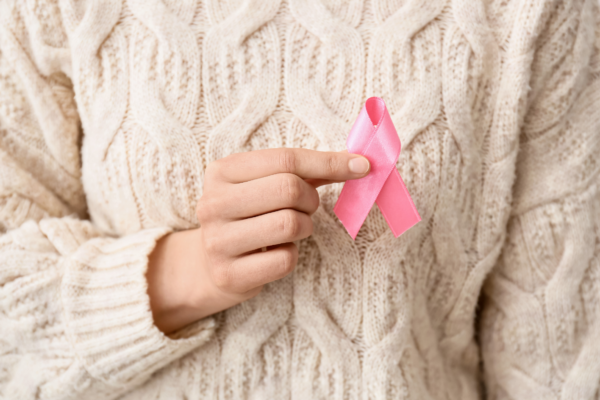
While October is the month of the rosary in the Catholic Church, October in the United States is National Breast Cancer Awareness month. The National Breast Cancer Foundation states October as an annual public health campaign to raise awareness for the impact of breast cancer and to raise funds to further research on breast cancer.
One component of National Breast Cancer Awareness month is educating women on how to conduct self-breast exams. Self-breast exam recommendations are a hot topic in medicine with the American Cancer Society and United States Preventative Services Task Force not recommending self-breast exams. However, the American College of Obstetrics and Gynecology (2017) continues to recommend breast self-awareness stating:
“Although breast-self examination is no longer recommended [by USPSTF], evidence of the frequency of self-detection of breast cancer provides strong rationale for breast self-awareness in the detection of breast cancer. Approximately 50% of cases of breast cancer in women 50 years and older and 71% of cases of breast cancer in women younger than 50 years are detected by women themselves. (40, 41). For example, 43% of the 361 breast cancer survivors who participated in the 2003 National Health Interview Survey reported detecting their cancer themselves (42). Additional evidence of the important role of breast cancer self- detection comes from a study of low-income women who received breast cancer care through California’s Breast and Cervical Cancer Treatment Program. Of the 921 women in the cohort, 64% detected their breast cancer (43)”.
Breast self-examination can help you become familiar with how your breasts normally look and feel. In fact, many natural family planning (NFP) models, like the Creighton model, have a reminder on the monthly cycle chart to conduct a breast self-exam. NFP can even inform the monthly changes breasts undergo. A woman charting using a cervical mucus observation method knows that when she starts seeing cervical mucus, her estrogen is rising. Rising estrogen stimulates the growth of milk ducts in the breasts. Rising estrogen also triggers ovulation. After a woman identifies her ovulation through temperature change, mucus observations, or hormone monitor readings (depending on which NFP model she is using), she knows that her progesterone begins to rise. Rising progesterone stimulates the growth of milk glands. This can lead to breast swelling, pain, and soreness before menstruation.
The National Breast Cancer Foundation (2021) recommends breast self-exams be performed in front of a mirror, in the shower, and while laying down. Women should stand in front of a mirror with their arms to their sides and visually inspect their breasts. They should look for changes in contour, dimpling, swelling, or changes in the nipple. Next, women should look for dimpling or puckering while their hands are placed on their hips and chest muscles are flexed. In the shower, check for lumps or bumps in each breast by using the flat pads of the middle three fingers with light, medium, and hard pressure all over the surface of each breast. Finally, while lying down with their arm raised above their head, women should use the same pressure and technique to check both breasts and armpit for lumps and bumps. Contact one of our MyCatholicDoctor providers, including myself, if you have any concerns.
A few ways to help cyclical breast pain include proper support and over the counter medications. If you suffer from premenstrual breast pain, try wearing a firm support bra before your period starts and ensure that you wear a tight-fitting sports bra during exercise. Hot or cold compresses can be used as well. Over the counter medications like Tylenol, acetaminophen, and naproxen sodium can all help too.
If you have breast pain and heavy periods, absence of periods, or irregular cycles, you may benefit from a total hormone evaluation to see if hormone imbalance is the cause of your breast pain. My medical practice can help you if you suffer from breast pain and cycle irregularities. Breast pain can cause lots of anxiety, but remember Proverbs 3:5 reminds us, “Trust in the Lord with all your heart.” And finally, Philippians 4:6-7 states “Have no anxiety at all, but in everything, by prayer and petition, with thanksgiving, make your requests known to God. Then the peace of God that surpasses all understanding will guard your hearts and minds in Jesus Christ.”
If you have had breast cancer or know someone who has suffered from breast cancer, there are several saints to invoke in prayer. St. Agatha, a third century martyr, is considered the patron saint of breast cancer. While imprisoned for refusing the sexual advances of a Roman magistrate, St. Agatha’s breasts were mutilated and shorn off. Another saint to invoke is St. Zelie Martin, who is believed to have died from breast cancer.
Sources:
American College of Obstetrics and Gynecology. (2017, July.) Breast Cancer Risk Assessment and Screening in Average-Risk Women
Kosloski, Phillip. (2017, September 26). Fighting breast cancer? Here is a saint for you
National Breast Cancer Foundation, Inc. (2021). Breast Self-Exam
Author: Megan Blum, Physician Assistant and Fertility Provider with MyCatholicDoctor
Editor: Samantha Wright, Director of Education and Online Resources with MyCatholicDoctor
About Megan: PA Megan Blum is a physician assistant with a special interest in providing restorative reproductive care to women of all ages. She has special training in FEMM and Marquette Method and is a medical consultant for both models of women’s healthcare. She became a medical provider to help provide access to fertility-awareness based medicine to all who seek it. She believes in finding the root cause of women’s health and endocrine issues to restore women’s bodies to optimum health.
Leave a reply
